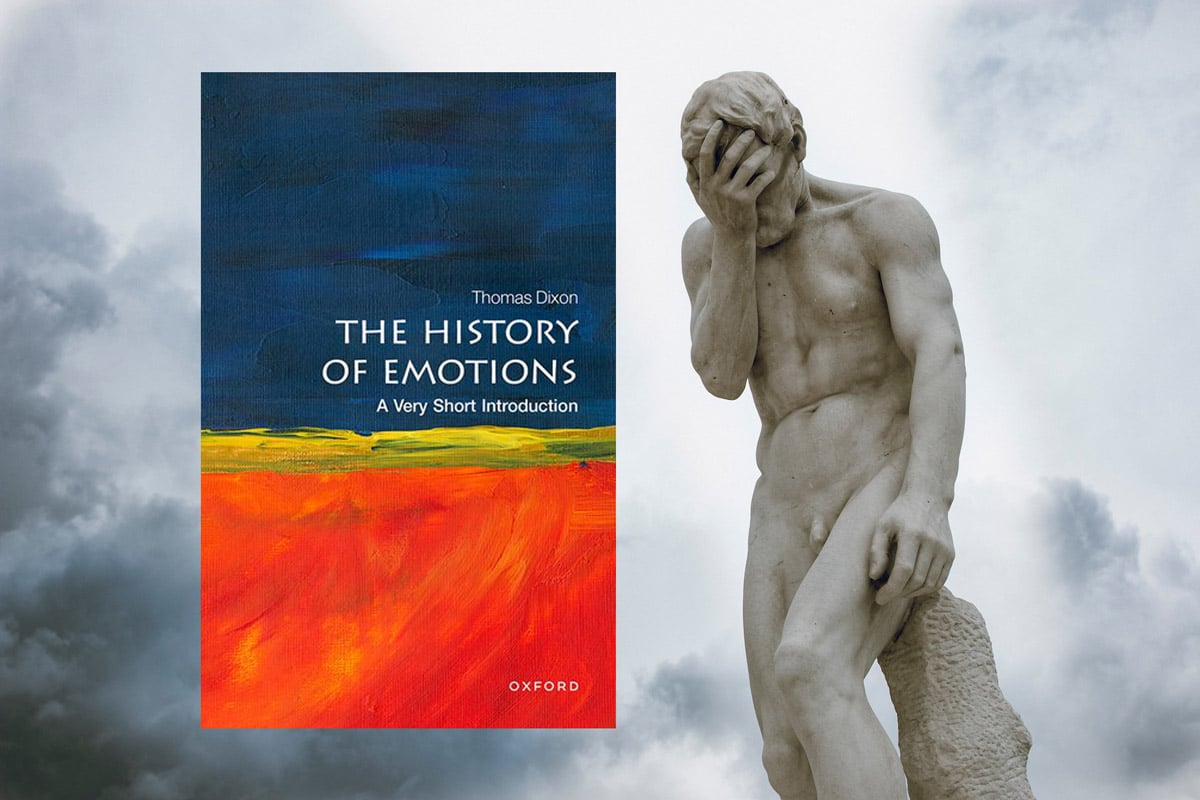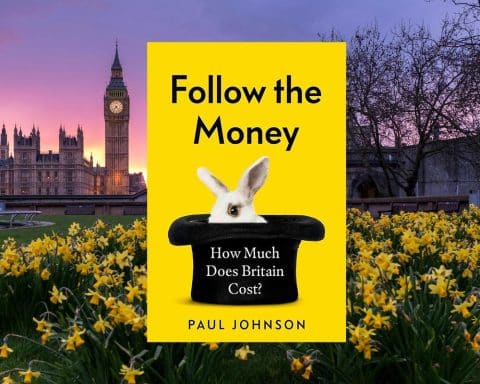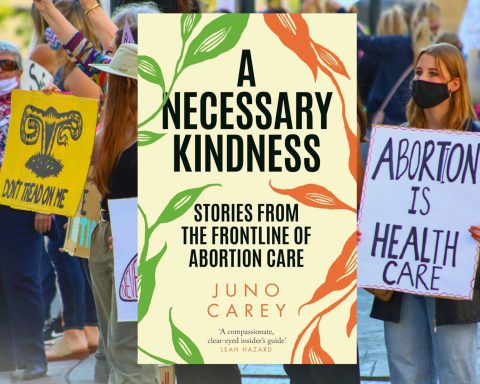Elke Hausmann is a salaried GP in Derby.
Thomas Dixon (Honorary Professor of History at Queen Mary University of London) has condensed 25 years of researching and teaching the history of emotions into a small book called ‘The History of Emotions: A Very Short Introduction’.
Studying the history of emotions is arguably one of the most important topics for understanding contemporary life, which becomes clear as you traverse this book. It is divided into several chapters that cover an extraordinary territory from generally introducing the reader to the history of the ‘history of emotions’ to how we can use the insights from this relatively new discipline to understand what we actually mean by emotions, and further trace how certain emotions have varied across cultures and times to give us a new perspective on our current understanding of emotions and their place in our lives.
The ‘history of emotions’
The history of emotions as a discipline started with the French historian, Lucien Febvre, who in 1941 asserted that ‘there should be no simple application of 20th century psychology to earlier historical periods’ (p.5). At the time, Freudian psychoanalysis was still dominant and often used to explain the motivations and feelings of historical individuals. The history of emotions tried to understand emotions in their own context, through historical accounts and language as well as objects. In the latter chapters of the book, Dixon demonstrates what we have learnt through ‘case studies of specific families of feeling — terror and happiness taken together, rage, and finally love’ (p.20). He shows how the study of the history of emotions ‘can be a liberating experience. To discover how radically different the interpretations, expressions and categories of feelings were in the past is to loosen the hold of our contemporary psychological notions over us’ (p.18).
“The concept of emotion itself is a relatively recent one.”
What are emotions?
So what are emotions? The concept of emotion itself is a relatively recent one. ‘In the most literal sense of the term, emotions are movements […] In its earliest uses in English, from around the 1560s, “emotions” could refer to civil disturbances or political conflicts’ (p.48). Today, we think of emotions as a ‘range of phenomena including grief, rage, love, joy, which we have learnt to think of as vivid inner feelings — the pre-packed properties of discreet individuals’ (p.124).
Dixon guides us through the different stages of how we have arrived at that understanding via Darwin and his idea of humanity’s shared ancestry with all living things, which connected bodily arousal to emotions, and ‘affect theory’, which combines approaches from evolutionary psychology and cybernetics to give us the idea that we all come with a basic set of emotions hardwired into our brains.
A complex dance of body and culture
Often today, ‘one standard psychological approach is to ask what emotions “we” have, or how “the brain” works, as if there were a singular answer that would be true for all brains and all humans at all times and places’ (p.18). In fact, ‘Human experience has also been revolutionized by medical inventions such as effective pain relief and contraception. If felt different to live in the world before these extraordinary technologies of control existed’ (p.6). It felt different to understand ‘their everyday experiences in terms of the influence of supernatural beings […] The fears and desires of such a world were not just the same emotions that modern psychology studies, but interpreted differently. The interpretation is an integral part of the emotion and therefore creates a fundamentally different experience’ (p.7). And that is the strength of the historical approach: ‘all our emotions are produced by a body and a historically situated culture working together. If one of the partners is missing, the results are no longer emotions, but either mere physiological reflexes or disembodied representations’ (p.23). It is this ‘complex dance of body and culture’ (p.23) that makes this approach so powerful.
“We rely on cultural scripts to interpret our inner feelings as particular emotions.”
Emotional communities
We rely on cultural scripts to interpret our inner feelings as particular emotions. Through language we become members of emotional communities — we have to remember that ‘attitudes to emotions in any particular era were not homogeneous. Rather, they varied according to which social group an individual belonged to […] In a single historical period, multiple, overlapping emotional communities exist, with potential conflicting ideas about emotion and expression’ (p.9). ‘Within any particular community, which could range in size from a close friendship of two people to a whole social class, there are often common views about which emotions exist, which are the most valuable, which are to be avoided, and when and how to show them’ (p.46). However, even within any given community, ‘there is a continuing relationship between an individual’s behaviour and the collective, rather than a complete dissolution of one within the other. Not everybody at a funeral weeps […] The history of emotions is a story of individuals in constant dynamic interaction with the social structures around them’ (p.71).
Languages of emotion
The relationship between words and feelings is quite complex. ‘”Performative speech acts” or ‘”performatives” are “not intended to convey factual information”, their main aim is to modify the thoughts and behaviours of other people’ (p.44). A subset is ’emotives’ — an example is: ‘To say […] “I have no fear”, in a time of danger, may partly be a report of an internal state of mind, but it is also an invitation to those hearing or reading the words to act in a particular way, whether offering comfort or, alternatively, issuing an invitation to emulate the speaker’s resilience. And […] a spoken claim about fear, or indeed any other emotion, might clarify, intensify, transform, or even invert the speaker’s own emotional state’ (p.45).
In addition to words, we also have access to non-verbal languages to express our emotions, for example, through body language, and in that sense ’emotions are frequently social performances, involving multiple learned non-verbal elements, whether the state of feeling is authentically represented by them or not. Indeed, we may not even know for sure ourselves whether our performances are wholly authentic or if we have perhaps unconsciously hammed things up a bit for our audience of loved ones or colleagues’ (p.56).
“The history of medicine is closely linked to the history of emotions.”
‘Passions of the soul’ versus the modern pro-emotive mantra
Before emotions, feelings were understood quite differently. For the Greeks, they were ‘pathe’ or ‘passions’: ‘in Latin passiones animae — passions of the soul— the dominant connotation was pathology (a term which shares its etymology with pathe). The passions were thought of as a moral and social problem to be wrestled with, often in a religious context […] A powerful sense of pathology is one of the things that was lost in the transition from “passions” to “emotions” as the dominant modern category of feelings’. (p.51)
To be or do good became to feel good: ‘For anyone learning about health and wellbeing today, whether in a classroom or via social media, the kind of message they are most likely to encounter is, “Your emotions are valid and you are loved”, or “Your feelings are your feelings — they and you both deserve respect”. This sort of pro-emotion mantra is in stark contrast to the ideas of moralists and philosophers of the past who warned against the connections between passions, irrationality, and sinful behaviour’ (p.51 and 52).
Emotions and the history of medicine
The history of medicine is closely linked to the history of emotions. Emotions have come under a medical model as ‘instincts, manias, phobias, complexes and disorders’ (p.44), for example, fear became ‘agoraphobia, claustrophobia (1870s), arachnophobia (1920s), school phobia (1940s)’ (p.75). Some of those terms have then been ‘taken out of that context to describe cultural and political phenomena, such as “Beatlemania” or “Islamophobia”‘ (p.44). Chapter 2, ‘A Map of Woe’, is also very relevant to doctors today, as it traces the understanding of melancholy and depression throughout history.
Applying the lessons from the history of emotions to our own lives
“I highly recommend this book to anyone who wants to understand where we are today.”
I highly recommend this book to anyone who wants to understand where we are today. Think about all the areas of your life where emotions matter: from the most obvious ones in our personal relationships to those in our consultation rooms, where we are confronted with our patients’ emotions as well as our own on a daily basis. Just think about the role of empathy, or more recently kindness, in our professional lives.
Think about the rise of populism in politics, where populist leaders press their potential voters’ emotional buttons in order to make them feel good temporarily, while presiding over the managed decline in our living conditions.
Think about how ‘a keen awareness of the natural world […] is at stake in environmental ethics in the 21st century’ (p.111), and in emotional responses to climate change and how those emotions are routinely being ridiculed by those in power, as historically both women and slaves have been accused of being too emotional (or indeed not emotional enough). Think about how that connects with the struggles of other marginalised groups to be seen for who they (think they) are.
Emotions make us who we are. The history of emotions can provide us with a framework to think differently about our lives, and Thomas Dixon has produced an excellent guide.
Featured book: Thomas Dixon, The History of Emotions: A Very Short Introduction, Oxford University Press, 2023, PB, 176pp, £8.99, 978-0198818298
Featured photo by Sergio Rodriguez – Portugues del Olmo on Unsplash.








